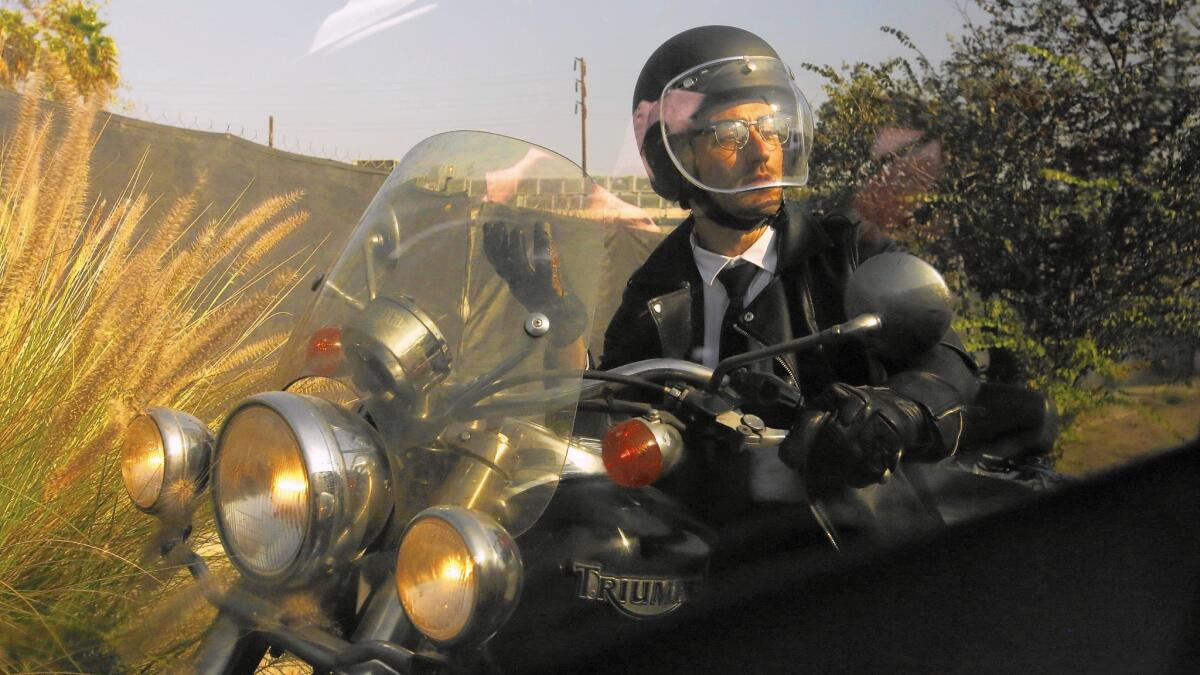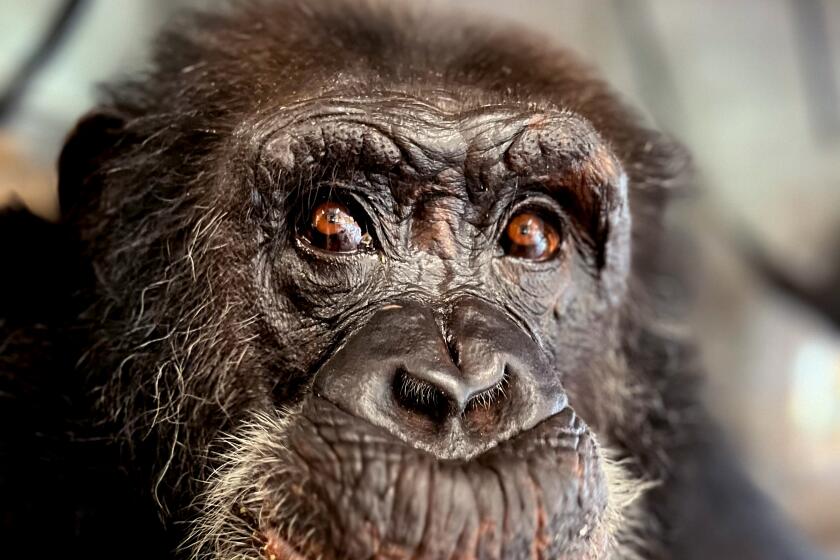Opera-on-wheels ‘Hopscotch’ drives home the complicated pull of downtown L.A.

Does Los Angeles need a true center, a downtown in the traditional sense? How about a reasonable facsimile of one, something just plausible enough to fool the visitors from out of town? Would that do the trick?
These questions, typically bouncing from sincerity to exasperation and back again, have preoccupied writers, planners, architects and civic boosters for nearly a century. They also play a pivotal role in shaping the wildly inventive, logistically miraculous “Hopscotch,” a mobile opera that will wrap up an extended run this weekend.
SIGN UP for the free Essential Arts & Culture newsletter >>
In the end, as a matter of fact, it’s the production’s thoughtful ambivalence about the complicated role downtown plays in Los Angeles — and how that role has shifted in recent years, with the rise of the lifestyle brand and gentrification juggernaut known as #DTLA — that helps salvage its reading of the city as a whole.
Produced by the Industry, a 5-year-old, experimentally minded Los Angeles opera company, “Hopscotch” is performed on three simultaneous color-coded routes. Its scenes take place both out in the city (on rooftops, in parks and plazas and along the Los Angeles River) and inside a rolling fleet of 24 limousines, which carry four audience members at a time alongside one or two performers.
The opera takes its name from a 1963 novel by Argentine writer Julio Cortázar, which is structured so that its chapters can be read in several different sequences. Instead of a table of contents, the book begins with a table of instructions.
“Hopscotch” has a similar curiosity about narrative structure, about how stories can be shuffled and reconfigured. Each group of four spectators experiences its own version of the opera, which follows a love affair between an artist named Lucha and a rebellious scientist named Jameson. The Industry’s Yuval Sharon and his collaborators — including six L.A. composers and as many librettists — eagerly undermine the idea that there is one overarching, official edition.
The version I saw last weekend, along the Green Route, began in an Airstream trailer parked in the hills north of Dodger Stadium before moving through Chinatown, the edge of Glassell Park and a few sections of downtown. Other routes stop in Boyle Heights and at the Bradbury Building.
A generation ago an experimental production of this kind would likely have taken place in Venice or Santa Monica. These days the musicians, the actors, the neighborhoods in flux and (perhaps most important of all) the streets free enough of traffic to make it work are almost universally located east of La Brea Avenue.
Car culture
Though the opera as Sharon envisioned it simply would not have been possible without the limos, “Hopscotch” is not just enabled by cars. It is also about cars and car culture, McLuhan on wheels. The mode of transportation is the message.
“The project began as an exploration of how cars alter our perception of our city and ourselves,” Sharon says in an interview in the “Hopscotch” program. “Cars can make L.A. feel so lonely, but they also offer freedom and possibility.”
At one point Jameson drives up alongside one of the limos on a motorcycle and carries on a conversation via wireless microphone with the actor inside. The two characters trade homilies about how driving is a ticket to a sublime kind of independence but keeps us cocooned, separate from one another.
This part of the libretto reads like a mash-up of the 2004 Paul Haggis movie “Crash”; the 1969 film “Easy Rider”; and Reyner Banham’s 1971 book, “Los Angeles: The Architecture of Four Ecologies,” which celebrates the roadways of Southern California as a blissful republic of their own called “Autopia.”
Banham famously writes in “Four Ecologies” that he “learned to drive in order to read Los Angeles in the original.” Though this take on the city is more than 40 years old, it underlies a good deal of “Hopscotch.”
The city that the production cuts through, that comes in and out of focus as the opera progresses, makes a different set of claims. Unlike the city Banham fell in love with, contemporary L.A., as it rehabilitates its historic architecture and makes agonizingly slow improvements to its transit network and public realm, is best understood at close range and a deliberate pace.
The faster you go, the more smoothly the circular routes of “Hopscotch” spin, the more you miss. No quick drive-by will reveal the subtle but telling ways in which the remade Clifton’s Cafeteria or Grand Central Market differ from the originals, for instance.
Range of ideas
To be fair, despite the tendency of “Hopscotch” to romanticize the private car and its place in Los Angeles civic culture, its structure is flexible enough to accommodate a range of other takes on the city. The opera is at its strongest when it operates as a generous and warmhearted primer on how many of the spaces of L.A., especially its public ones, are underused and full of potential.
In its best, most curious moments it recalls not Banham nor “Crash” but the gruff appeal of the Thom Andersen documentary “Los Angeles Plays Itself,” the artwork of Ruben Ochoa, the essays of Esther McCoy and John Chase, the communal energy of CicLAvia and the words of writer David Kipen: “Los Angeles is like your brain. You only ever use 20% of it. But imagine if we used it all.”
The experience of riding in one of the limousines also mirrors the growing variety of ways in which we encounter 21st century Los Angeles not as solo drivers but as passengers; this is the common ground of the carpool, the Uber ride and the trip by bus or light rail. The shift from driver to passenger is also a shift from author or performer to spectator, from doing to watching, or from one kind of watching to another. “Hopscotch” touches on that idea in a range of fascinating ways.
A convergence
As the opera progresses, the pull of downtown, evident from the beginning, grows stronger. As the second-to-last scene begins, each of the limousines turns toward the Arts District.
On the Green Route, Lucha recites a string of hopes, goals and obligations — a combination of a prayer and mundane to-do list — as she sits in the front seat, looking out over the taillights on the 110. She reminds herself “to remember the present, to not forget everyone’s names, to close the windows, to lock the doors, to get the mail.” And she sings repeatedly, in a hesitant mantra, about trying “to find the center.”
Her limousine, converging with all the others in a circling of the high-end wagons, then pulls into a roofless temporary pavilion in the parking lot of the Southern California Institute of Architecture, in a low-rise section of downtown between the skyscrapers of Bunker Hill and the L.A. River. A show that has no single starting point goes out of its way to bring everybody together for the finale.
The pavilion, designed by SCI-Arc faculty members Constance Vale and Emmett Zeifman, is a version of a center, yes, but a contrived and fleeting one: a Potemkin civic commons.
For the Los Angeles of 2015, a city rediscovering the appeal of a vital downtown but reluctant to abandon all the ways it has historically thrived by being dispersed and polycentric — precisely by being different from other, older cities — that combination seems about right.
Even if the center cannot hold in Los Angeles, it’s useful every once in a while to pretend it can, to act as if it might.
christopher.hawthorne@latimes.com
More to Read
The biggest entertainment stories
Get our big stories about Hollywood, film, television, music, arts, culture and more right in your inbox as soon as they publish.
You may occasionally receive promotional content from the Los Angeles Times.











